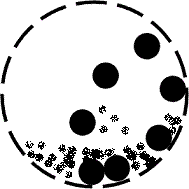Ball mill: Difference between revisions
mNo edit summary |
|||
| Line 8: | Line 8: | ||
== Grinding media == |
== Grinding media == |
||
[[Image:grindingmedia.JPG|frame|Lead antimony grinding media with aluminum powder.]]There are many types of grinding media suitable for use in a ball mill, each material having its own specific properties and advantages. Common in some applications are [[stainless steel]] balls. While usually very effective due to their high density and low contamination of the material being processed, stainless steel balls are unsuitable for some applications, including: |
[[Image:grindingmedia.JPG|frame|Lead antimony grinding media with aluminum powder.]]There are many types of grinding media suitable for use in a ball mill, each material having its own specific properties and advantages. Common in some applications are [[stainless steel]] balls. While usually very effective due to their high density and low contamination of the material being processed, stainless steel balls are unsuitable for some applications, including: |
||
*Black powder and other flammable materials require non-sparking [[lead]] [[antimony]], [[brass]], or [[bronze]] grinding media |
*Black powder and other flammable materials require non-sparking [[lead]], [[antimony]], [[brass]], or [[bronze]] grinding media |
||
*Contamination by iron of sensitive substances such as ceramic raw materials. In this application [[ceramic]] or [[flint]] grinding media is used. Ceramic media are also very resistant to corrosive materials. |
*Contamination by iron of sensitive substances such as ceramic raw materials. In this application [[ceramic]] or [[flint]] grinding media is used. Ceramic media are also very resistant to corrosive materials. |
||
[[Image:Ball_Mill.jpg|thumb|right|300px|A ball mill inside the [[Mayflower Mill]] near [[Silverton, Colorado]].]] |
[[Image:Ball_Mill.jpg|thumb|right|300px|A ball mill inside the [[Mayflower Mill]] near [[Silverton, Colorado]].]] |
||
Revision as of 22:33, 4 May 2008
A ball mill is a type of grinder used to grind materials into extremely fine powder for use in paints, pyrotechnics, and ceramics.


Description
A ball mill, a type of grinder, is a cylindrical device used in grinding (or mixing) materials like ores, chemicals, ceramic raw materials and paints. Ball mills rotate around a horizontal axis, partially filled with the material to be ground plus the grinding medium. Different materials are used as media, including ceramic balls, flint pebbles and stainless steel balls. An internal cascading effect reduces the material to a fine powder. Industrial ball mills can operate continuously, fed at one end and discharged at the other end. Large to medium-sized ball mills are mechanically rotated on their axis, but small ones normally consist of a cylindrical capped container that sits on two drive shafts (pulleys and belts are used to transmit rotary motion). A rock tumbler functions on the same principle. Ball mills are also used in pyrotechnics and the manufacture of black powder, but cannot be used in the preparation of some pyrotechnic mixtures such as flash powder because of their sensitivity to impact. High-quality ball mills are potentially expensive and can grind mixture particles to as small as 0.0001 mm, enormously increasing surface area and reaction rates.
Grinding media
There are many types of grinding media suitable for use in a ball mill, each material having its own specific properties and advantages. Common in some applications are stainless steel balls. While usually very effective due to their high density and low contamination of the material being processed, stainless steel balls are unsuitable for some applications, including:
- Black powder and other flammable materials require non-sparking lead, antimony, brass, or bronze grinding media
- Contamination by iron of sensitive substances such as ceramic raw materials. In this application ceramic or flint grinding media is used. Ceramic media are also very resistant to corrosive materials.

See also
- Cement mill
- Ball-nosed milling cutters, sometimes informally called "ball mills"
